Do you often feel a dull ache or stiffness in your knee, especially after long hours of walking or standing? Or maybe, you’ve noticed that climbing stairs or getting up from a chair has become more painful over time. If this sounds familiar, you might be dealing with knee osteoarthritis, a condition that affects millions of people, especially as we get older.
But don’t worry—there’s hope! In this blog, we’ll guide you through the symptoms, causes, and treatment options for knee osteoarthritis. Whether you’re looking for non-surgical ways to manage the pain or wondering if surgery is the next step, we’ve got you covered.
So if you’re ready to take control of your knee health and learn how to live a more comfortable life with knee osteoarthritis, keep reading!
What is Osteoarthritis of the Knee?
 Osteoarthritis (OA) of the knee is a degenerative joint condition where the cartilage in the knee joint breaks down over time. Cartilage normally cushions the knee, allowing smooth movement. When it deteriorates, the bones begin to rub against each other, causing pain, stiffness, and reduced flexibility.
Osteoarthritis (OA) of the knee is a degenerative joint condition where the cartilage in the knee joint breaks down over time. Cartilage normally cushions the knee, allowing smooth movement. When it deteriorates, the bones begin to rub against each other, causing pain, stiffness, and reduced flexibility.
Here’s how it affects the knee joint:
-
Cartilage Breakdown: As the protective cartilage wears down, it leads to friction between the bones, causing inflammation and discomfort.
-
Pain and Swelling: With the loss of cartilage, the knee may feel sore, swollen, and stiff, especially after activities that involve weight-bearing or repetitive movement.
-
Reduced Mobility: As the condition progresses, bending, walking, or climbing stairs can become increasingly difficult due to pain and swelling.
-
Worsening Symptoms: Knee osteoarthritis often gets worse over time, affecting mobility and making simple tasks like walking or sitting uncomfortable.
Knee osteoarthritis is commonly seen in older adults, but it can also affect younger people, especially those with previous knee injuries, obesity, or genetic factors. The pain and stiffness from OA can significantly impact daily life, but with the right treatments, it’s possible to manage the symptoms and improve your quality of life.
Common Causes of Knee Osteoarthritis
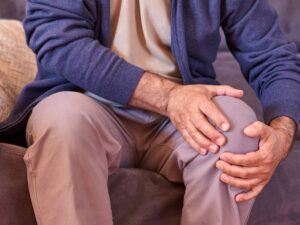 Knee osteoarthritis doesn’t happen overnight; it develops over time due to a combination of genetic factors, injuries, and lifestyle choices. Here are the most common causes and risk factors for knee osteoarthritis:
Knee osteoarthritis doesn’t happen overnight; it develops over time due to a combination of genetic factors, injuries, and lifestyle choices. Here are the most common causes and risk factors for knee osteoarthritis:
-
Age
Most people over the age of 50 begin to experience some level of knee osteoarthritis. It’s more common in individuals over 60, as joint wear and tear naturally increases over time.
-
Injury or Trauma
Previous knee injuries, such as fractures, ligament tears, or meniscus damage, can increase the risk of developing osteoarthritis later in life.
-
Obesity
Excess weight puts extra pressure on the knee joints, increasing the wear on cartilage. Obesity also promotes inflammation in the body, which can further damage the joints.
-
Genetics
If your parents or siblings have had it, you’re more likely to develop the condition yourself. Certain genetic factors can influence cartilage structure and joint health.
-
Overuse and Repetitive Motion
Repetitive activities such as running, jumping, or heavy lifting can put excessive strain on the knee joints, contributing to cartilage breakdown over time.
-
Gender
Women, especially after menopause, are more likely to develop knee osteoarthritis than men. Hormonal changes may contribute to the weakening of cartilage and the onset of osteoarthritis in women.
Understanding these risk factors helps you better manage your knee health and take preventive measures. While some causes like age and genetics cannot be controlled, you can take action to reduce the risk by maintaining a healthy weight, avoiding injury, and staying active.
Symptoms of Knee Osteoarthritis You Should Watch Out For
- Pain in the Knee during movement or after activity.
- Stiffness in the knee, especially after rest or in the morning.
- Swelling around the knee joint, which may increase after physical activity.
- Difficulty moving the knee or bending it fully.
- Grinding or popping sounds when moving the knee.
- Weakness in the knee, making it feel unstable.
- Reduced flexibility or limited range of motion in the knee.
- Pain while walking or difficulty walking for extended periods.
If you experience any of these symptoms, it’s important to consult an orthopedic specialist for a proper diagnosis and treatment plan.
How Knee Osteoarthritis Impacts Your Mobility
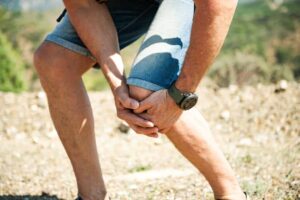 Living with knee osteoarthritis can make even simple tasks feel challenging. For instance, something as routine as walking might become painful and exhausting. You might find yourself walking more slowly, limping, or avoiding long walks altogether because the pain makes it hard to keep going.
Living with knee osteoarthritis can make even simple tasks feel challenging. For instance, something as routine as walking might become painful and exhausting. You might find yourself walking more slowly, limping, or avoiding long walks altogether because the pain makes it hard to keep going.
- Climbing stairs can also become a struggle. Even standing for long periods can become unbearable.
- Bending or squatting can also become tough.
- Running, squatting, or even low-impact activities like walking or cycling can become painful or impossible due to the strain it places on the knee.
- Even getting in and out of a car can feel like an obstacle.
- Lastly, sitting for long periods, whether working or relaxing, can also trigger discomfort.
Knee osteoarthritis affects many aspects of daily life, but with the right treatment and adjustments, you can regain some of that lost mobility and continue to do the things you enjoy. Managing the pain and maintaining mobility is key to keeping up with your routine and staying active.
Non-Surgical Treatment Options for Knee Osteoarthritis
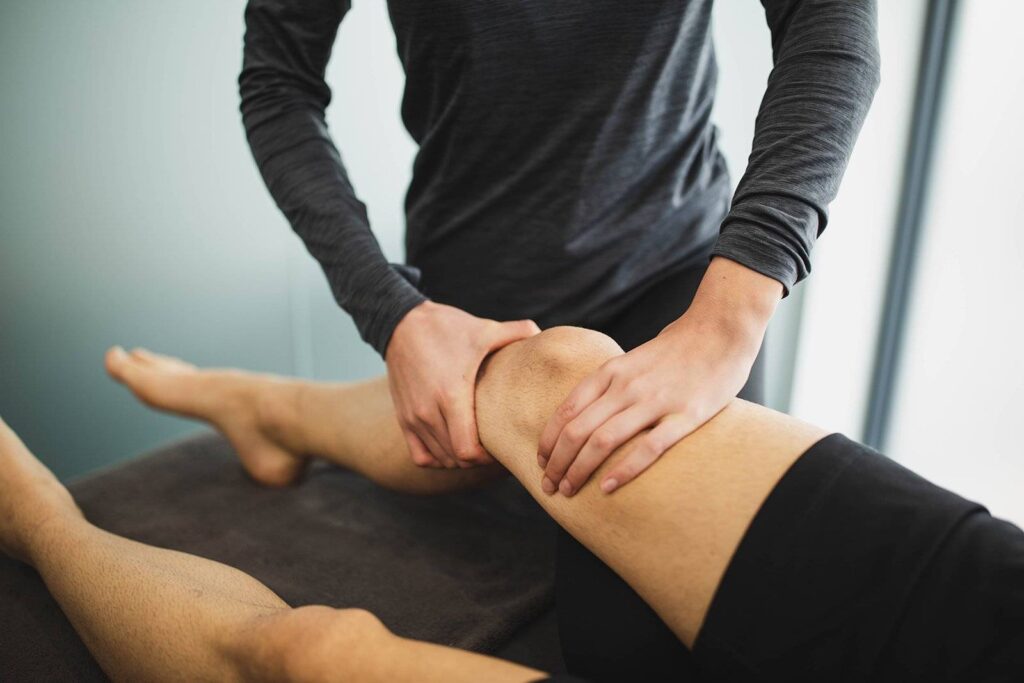
If you’re dealing with knee osteoarthritis, surgery isn’t always the first option. In fact, there are several non-surgical treatments that can help manage symptoms, reduce pain, and improve mobility. Here are some effective treatments:
- Medications
Pain management is crucial when living with knee osteoarthritis. Over-the-counter pain relievers, such as acetaminophen or NSAIDs like ibuprofen, can reduce pain and inflammation. If your pain is more severe, a doctor might prescribe stronger medications or corticosteroid injections to relieve inflammation in the knee joint.
- Physical Therapy
Physical therapy is a highly effective way to strengthen the muscles around the knee, which helps reduce strain on the joint. A physical therapist will guide you through specific exercises to improve flexibility, mobility, and strength. These exercises can ease pain and prevent further joint damage by keeping the knee joint active and healthy.
- Lifestyle Changes
Simple lifestyle changes can have a significant impact on managing knee osteoarthritis. Maintaining a healthy weight reduces the pressure on your knees, preventing further wear and tear. Regular, low-impact exercises like swimming or cycling can help you stay active without aggravating the condition. Managing your diet to include anti-inflammatory foods, like omega-3 fatty acids and antioxidants, can also reduce inflammation and help manage symptoms.
- Braces and Supports
Using a knee brace or support can provide stability to the joint, reducing pain and preventing further injury. A brace can help redistribute the weight off the knee, provide additional support, and improve mobility during physical activities. It’s especially useful when doing daily tasks or exercising.
These non-surgical treatments can go a long way in managing knee osteoarthritis. With the right combination of medications, physical therapy, lifestyle changes, and bracing, you can continue to move comfortably and improve your quality of life without immediately resorting to surgery. Always consult with your doctor to find the best plan tailored to your needs.
Surgical Treatments for Knee Osteoarthritis
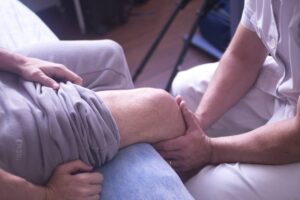 If the pain and stiffness are persistent and affect your mobility, here are the surgical options that might be considered:
If the pain and stiffness are persistent and affect your mobility, here are the surgical options that might be considered:
- Knee Arthroscopy
Knee arthroscopy is a minimally invasive procedure used to diagnose and treat knee joint problems. During this surgery, small incisions are made in the knee, and a camera (arthroscope) is inserted to view the joint. The surgeon may remove damaged cartilage, clean up the joint, or repair any torn tissue. It can help relieve pain and improve knee function without the need for a full knee replacement.
- Partial Knee Replacement
In some cases of knee osteoarthritis, only part of the knee joint is affected. A partial knee replacement may be performed if only one area of the knee has worn down, usually the inner part of the knee. This surgery involves replacing the damaged part of the joint with a prosthetic while leaving the healthy tissue intact. It can provide significant relief with a shorter recovery time than total knee replacement.
- Total Knee Replacement (TKA)
For severe knee osteoarthritis where the joint has been extensively damaged, a total knee replacement may be necessary. During this procedure, the damaged parts of the knee joint are removed and replaced with an artificial joint. This procedure provides long-lasting relief and allows the patient to regain function, although recovery can take several weeks to months.
Surgical treatments are typically considered when the pain and functional limitations are no longer manageable with non-surgical methods, or when joint damage is severe. If you’re facing advanced knee osteoarthritis and other treatments haven’t worked, your orthopedic surgeon will help determine the right surgical option for you based on your symptoms and overall health.
How to Manage Knee Osteoarthritis Pain at Home
Managing knee osteoarthritis pain at home can significantly improve your quality of life and help you stay active. Here are some practical and simple ways to relieve pain and make daily tasks more comfortable:
-
Take breaks from activities that strain your knee.
-
Elevating the knee can also help reduce swelling. Simply prop your leg up on a pillow to allow gravity to help fluid drain from the knee joint.
-
Place an ice pack on the knee for 15-20 minutes several times a day, especially after any activity that causes pain or stiffness.
-
For chronic stiffness, heat therapy can be soothing. Use a warm compress or heating pad to relax the muscles and improve circulation around the joint.
-
Over-the-counter pain medications like acetaminophen or NSAIDs (e.g., ibuprofen) can help manage pain and inflammation.
-
Gentle exercises can help improve joint mobility and reduce stiffness. Start with low-impact activities like quadriceps sets, leg lifts, and hamstring stretches.
-
Maintaining a healthy weight can significantly reduce the pressure on your knees, easing pain and preventing further damage.
-
Use a knee brace or compression sleeve to provide extra support to the knee joint, reducing pain and improving stability.
-
If you have knee osteoarthritis, adopting a healthy diet that’s rich in anti-inflammatory foods (like omega-3 fatty acids, fruits, and vegetables) can help reduce joint inflammation. Avoid foods that may trigger inflammation, like processed foods and excess sugar.
Incorporating these strategies into your daily routine can provide significant relief and help manage knee osteoarthritis symptoms without needing immediate medical intervention. If pain persists or worsens, it’s important to consult an orthopedic specialist for further evaluation and tailored treatment.
Where to Find an Orthopedic Specialist for Knee Osteoarthritis
If your knee pain becomes unmanageable, or if it’s starting to affect your mobility and day-to-day activities, it’s time to consult an orthopedic specialist. If home remedies and non-surgical treatments aren’t providing enough relief, an orthopedic doctor can evaluate your condition and recommend further steps, such as physical therapy, medications, or even surgery if necessary.
Here’s how to find an orthopedic specialist who can help:
-
-
You can visit nearby hospitals or clinics where orthopedic specialists are available for consultation. Most hospitals have dedicated orthopedic departments where you can get the right treatment plan for knee osteoarthritis.
-
If visiting a clinic is not convenient, you can easily connect with an orthopedic specialist through MantraDoc. MantraDoc offers online consultations with highly qualified orthopedic doctors who can provide advice, diagnose your condition, and suggest a treatment plan—all from the comfort of your home.
👉 Click here to book an online consultation with an orthopedic specialist today!
Don’t wait for the pain to get worse. Consulting an orthopedic doctor can help you take the right steps toward managing knee osteoarthritis and improving your quality of life. Get expert advice and treatment options today with MantraDoc!
 Osteoarthritis (OA) of the knee is a degenerative joint condition where the cartilage in the knee joint breaks down over time. Cartilage normally cushions the knee, allowing smooth movement. When it deteriorates, the bones begin to rub against each other, causing pain, stiffness, and reduced flexibility.
Osteoarthritis (OA) of the knee is a degenerative joint condition where the cartilage in the knee joint breaks down over time. Cartilage normally cushions the knee, allowing smooth movement. When it deteriorates, the bones begin to rub against each other, causing pain, stiffness, and reduced flexibility. Knee osteoarthritis doesn’t happen overnight; it develops over time due to a combination of genetic factors, injuries, and lifestyle choices. Here are the most common causes and risk factors for knee osteoarthritis:
Knee osteoarthritis doesn’t happen overnight; it develops over time due to a combination of genetic factors, injuries, and lifestyle choices. Here are the most common causes and risk factors for knee osteoarthritis:
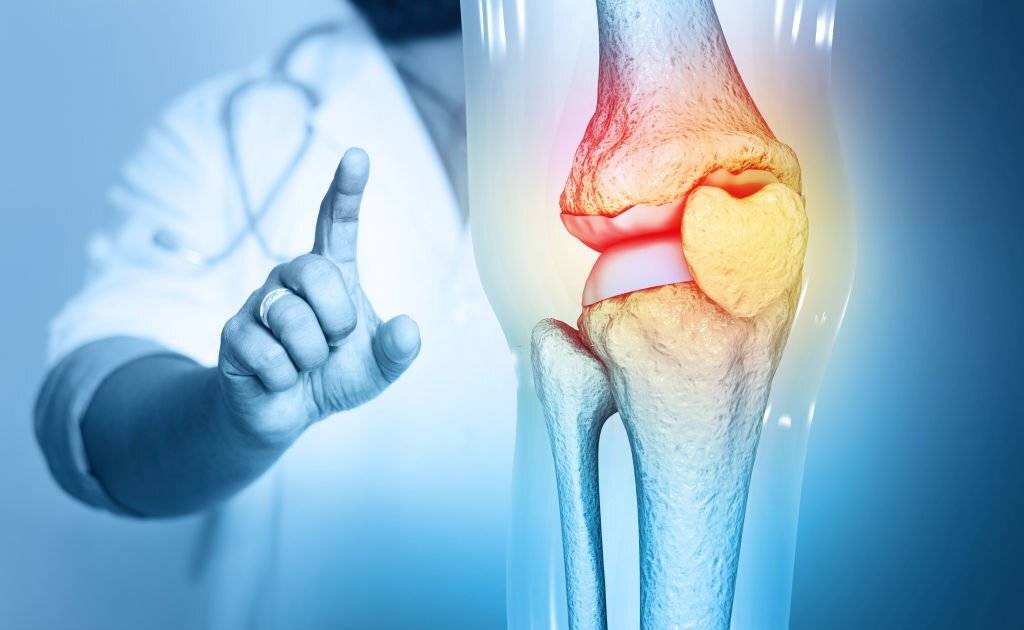


 If the pain and stiffness are persistent and affect your mobility, here are the surgical options that might be considered:
If the pain and stiffness are persistent and affect your mobility, here are the surgical options that might be considered: